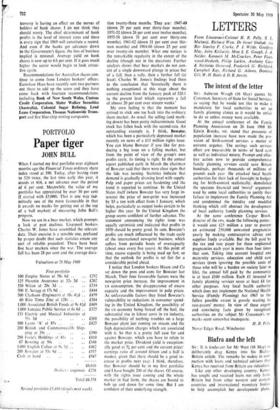Paper tiger
PORTFOLIO JOHN BULL
When I started my first portfolio over eighteen months ago the Financial Times ordinary share index stood at 390. Today, after having risen to 520 twice, the last time early this year, it stands at 414, a net advance over the period of 6 per cent. Meanwhile, the value of my portfolio has appreciated by over 30 per cent (I started with £5,000). That is one way (ad- mittedly one of the more favourable in that it awards no marks for getting out at the top of a bull market) of measuring John Bull's progress.
Now we are in a bear market, which prompts a look at past declines. Liverpool brokers Charles W. Jones have assembled the relevant data. Their exercise is a sensible one, prefaced by proper doubt that such statistics create any sort of reliable precedent. There have been five bear markets since the war. The average fall has been 28 per cent and the average dura-
Valuations at 28 May 1969 First portfolio 100 Empire Stores at 58s 6d £292 125 Phoenix Assurance at 32s 3d .. £202 330 Witan at 20s 3d £334 500 E. Scragg at 17s 9d £444 500 Clarkson (Engineers) at 18s 4jd .. 1459 60 Rito Tinto Zinc at 128s £384 1,000 Associated British Foods at 9s 4fd £469 1,000 Jamaica Public Service at 6s 6d .. £325 133 Electric and Musical Industries at 55s 3d . . . . 1368
100 Lyons 'A' at 85s -£425 200 British and Commonwealth Ship-
ping at 39s £390 200 Forte's Holdings at 41s £410 67 Bowring at 50s £168 1,000 English Calico at 9s 3d £462 200 Bowater at 53s 9d £537 Cash in hand .. £947 "‘ £6,616 Deduct : expenses £258 Total £6,358 Second portfolio £5,400 (details next week). lion twenty-three months. They are: 194749 (down 29 per cent over thirty-four months), 1951-52 (down 26 per cent over twelve months), 1955-58 (down 31 per cent over thirty-one months), 1961-62 (down 31 per cent over thir- teen months) and 1964-66 (down 25 per cent over twenty-six months). What one notices is the remarkable regularity in the extent of the decline (though not in the duration). Further analysis shows that bear markets do not con- sist of a single downward plunge in prices but of a fall, then a rally, then a further fall (at least). Charles W. Jones's findings lead them to the conclusion that 'historically there is nothing exceptional at this stage about the current decline from the January peak of 520.1 to the present level which represents a fall of almost 20 per cent over sixteen weeks.'
My own feeling is that the moment has arrived to stick one toe back into the ordinary
share market. As usual, the selling (and mark- ing down) has been pretty indiscriminate. Good stock has fallen back with the second-rate. An outstanding example is, I think,. Bowater, which has been a particularly depressed market recently on news of a £15 million rights issue. You can blame Bowater if you like for pro- ducing a big issue on a falling market, but from the point of view of the group's own profits cycle, its timing is right. In the annual report published early in March the chairman of Bowater said that there were clear signs that the tide was turning. Statistics indicate that - demand is gradually drawing level with supply. Pulp and paper prices are hardening and the trend is expected to continue. In the United States itself (where Bowater has very large in- terests) the price of newsprint was increased by $5 a ton with effect from 1 January, which helps, particularly as output looks certain to be higher this year. In the United Kingdom the group seems confident of further advance. The statement announcing the rights issue was equally optimistic and indicated that profits in 1970 should be pretty good. In sum, Bowater's profits are much influenced by the trade cycle of the international newsprint business, which suffers from periodic bouts of overcapacity (about once every five years). At this point of time, excess capacity is being used up fast, so that the outlook for profits is set fair. for a considerable period ahead.
I notice that London brokers Hoare and Co set down the pros and cons for Bowater last March. Their four favourable factors were the newsprint price increase, the improvement in us consumption, the disappearance of excess capacity and the improvement in pulp prices. As unfavourable factors they listed Bowater's vulnerability to reductions in consumer spend- ing in the United Kingdom, the possibility of the us economy being forced off the boil, the substantial rise in labour costs in us industry, the possibility of teething troubles on a large Bowater plant just coming on stream and the high depreciation charges which are associated with it. So that is a pretty full case for and against Bowater, which you have to relate to the market price. Dividend yield is exception- ally good at 51 per cent and the current price/ earnings ratio of around fifteen and a half is modest, given that there should be a good in- crease in profits next year. I think, therefore, that Bowater should be in my first portfolio and I have bought 200 of the shares. Of course, with the rights issue coming and the whole market in bad form, the shares are bound to bob up and down for some time. But I am confident of their underlying strength.


































 Previous page
Previous page